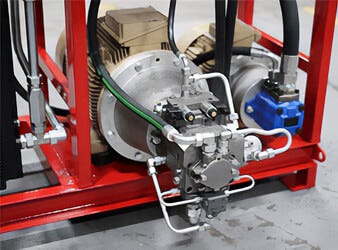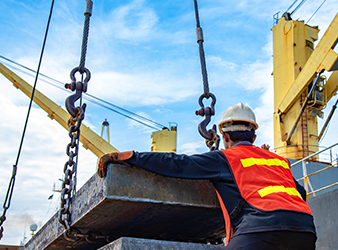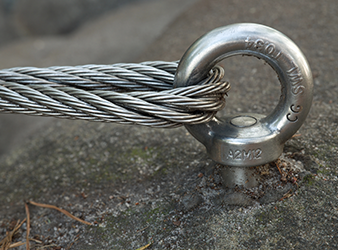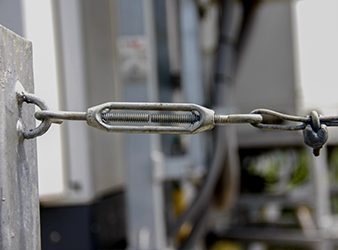Different Types of Hydraulic Pumps and Their Applications
- By Empire Rigging
- Oct 7, 2025

Hydraulic pumps are essential for a wide range of heavy-duty tasks, from lifting and pressing to moving and clamping. Choosing the right pump can significantly impact efficiency, safety, and performance in industries that depend on hydraulic systems, such as construction, manufacturing, rigging, and maintenance.
Hydraulic pumps are built for durability and high-pressure performance on construction sites, making them ideal for rigid material handling tasks. In this guide, we’ll explain the main types of hydraulic pumps available, how they operate, and the best uses for each.
What Is a Hydraulic Pump?
A hydraulic pump is a mechanical device that converts mechanical energy into hydraulic energy by moving fluid through a system to produce force and motion. It draws fluid from a reservoir, increases pressure by restricting the fluid’s path, and directs it through valves and hoses to power hydraulic tools, cylinders, and equipment.
Hydraulic pumps used in rigging and material handling are usually positive-displacement pumps, which means they move a fixed amount of fluid per rotation or cycle. These pumps can generate the high pressures needed to lift loads, crimp components, or operate jacks and presses.
Key Types of Hydraulic Pumps and Their Applications
Hydraulic pumps come in various types, each designed to meet specific performance needs depending on the task. While all hydraulic pumps perform the same basic function—moving fluid through a system to generate force—their internal mechanisms and operational styles differ. The most common types used in material handling, lifting, and industrial maintenance are in the positive-displacement category, meaning they deliver a consistent volume of fluid per cycle.
Among positive-displacement pumps, piston pumps are the most commonly used in high-pressure hydraulic systems. These are usually available in both manual (hand-operated) and electric (motor-driven) versions, providing versatility for various environments—from fieldwork and mobile repairs to shop-based manufacturing.
Understanding the differences between these types is crucial when choosing a hydraulic pump that meets your system’s pressure, flow rate, and mobility needs. Below is an overview of the main hydraulic pump types commonly used in industrial and rigging applications, along with their advantages and typical uses.
1. Manual Hydraulic Hand Pumps
Manual hand pumps are operated by a lever or handle that the user manually activates. They’re compact, portable, and don’t require an external power source, making them perfect for field work, small-scale operations, or emergency backups.
Best for
• Portable lifting or jacking applications
• Pressing or crimping jobs with minimal fluid demand
• Maintenance and repair tasks where electricity is unavailable
Advantages
• Lightweight and easy to transport
• Simple design with minimal maintenance needs
• Affordable entry point into hydraulic systems
Considerations
• Requires manual labor; not ideal for repetitive or high-volume jobs
• Slower operation compared to powered pumps
Some manual pumps are available in single-speed versions for steady fluid flow or in two-speed models that provide faster flow at low pressure and automatically switch to high pressure when resistance rises.
2. Electric Hydraulic Pumps
Electric hydraulic pumps are powered by motors and designed for faster operation and continuous use. These pumps are commonly used in shop environments, production settings, or job sites where steady hydraulic flow is needed for extended periods.
Best for
• High-cycle, repetitive tasks
• Industrial applications involving multiple cylinders or tools
• When precise control and high flow rate are required
Advantages
• Higher speed and efficiency than manual pumps
• Consistent pressure and flow output
• Available in single-stage or two-stage configurations
Considerations
• Requires a power source (typically 115V or 230V AC)
• Heavier and more complex than manual models
• May require more maintenance due to electrical components
Two-stage electric pumps are especially efficient: they operate at high flow during the first stage (low pressure) and automatically switch to a lower flow rate when higher pressure is needed. This design helps complete cycles more quickly and reduces wear on tools and seals.
3. Portable Hydraulic Power Units
Hydraulic power units (HPUs) are self-contained systems that consist of a pump, motor, reservoir, and necessary control valves. They are typically used to operate multiple hydraulic tools or systems from a single power source.
Best for
• Mobile service trucks or on-site maintenance
• Running multiple tools simultaneously
• Applications requiring quick setup and teardown
Advantages
• Compact and self-contained
• Fast setup and teardown time
• Supports more advanced hydraulic operations
Considerations
• Generally more expensive
• May require cooling systems depending on use
Choosing the Right Pump for the Job
When choosing a hydraulic pump, you should match the pump type to your application’s requirements. Here are some key factors to consider:
Pressure Requirements
Most hydraulic tools require pressures up to 10,000 psi. Make sure the pump you select is rated for the pressure range your tools require. Manual pumps are suitable for low-to-mid pressure tasks, while electric pumps easily handle higher pressures.
Flow Rate
Flow rate influences the speed of your hydraulic system. Low flow results in slower tool movement, while higher flow increases cycle speed. Electric pumps provide much higher flow rates than hand pumps, making them more suitable for production work.
Portability
A compact hand pump or portable power unit is ideal if your work is mobile or outdoors. For shop use, an electric pump on a cart or workstation provides performance and convenience.
Frequency of Use
For occasional or light-duty jobs, a manual pump is usually sufficient. For repetitive, high-volume tasks, an electric pump is a valuable investment that lessens operator fatigue and boosts productivity.
Positive Displacement Pump Basics
When choosing a lifting sling, keep the following in mind:Hydraulic pumps used in lifting and rigging are all positive displacement, meaning they move a fixed amount of fluid each cycle. Blocking the outlet of a positive-displacement pump causes rapid pressure buildup, so proper relief valves are essential.
Within positive displacement pumps, the three primary types are:
• Piston Pumps: High efficiency, high pressure, and commonly used in industrial applications. These are the most common types found in Empire Rigging’s lineup.
• Gear Pumps: Simple and affordable, but usually not used for ultra-high-pressure applications.
• Vane Pumps: Quiet and smooth, typically used in medium-pressure applications but less frequently in rigging and lifting equipment.
Empire Rigging specializes in piston-style pumps because of their durable performance, accurate control, and capacity to meet the high-pressure demands of rigging environments.
Maintenance Tips for Hydraulic Pumps
No matter what kind of hydraulic pump you select, proper maintenance guarantees longer durability and safer performance.
• Check Fluid Levels Regularly: Low oil levels can cause cavitation and result in pump failure.
• Use Clean Hydraulic Oil: Contaminated fluid damages seals and internal parts.
• Inspect Seals and Connections: Leaks decrease performance and may allow air into the system.
• Follow Load Ratings: Never surpass the pressure or flow limits of your pump or hydraulic tools.
Hydraulic pumps are essential for successful rigging, lifting, and industrial operations. Whether you need a durable hand pump for mobile jobs or a high-capacity electric pump for heavy-duty workshop tasks, selecting the right type ensures safety, efficiency, and long-lasting performance.
At Empire Rigging, the pumps we offer are chosen for their durability, performance, and compatibility with your hydraulic systems. By understanding the differences between manual and electric piston pumps—and how they fit your specific jobsite needs—you’ll be able to select the best option for your equipment and team.






